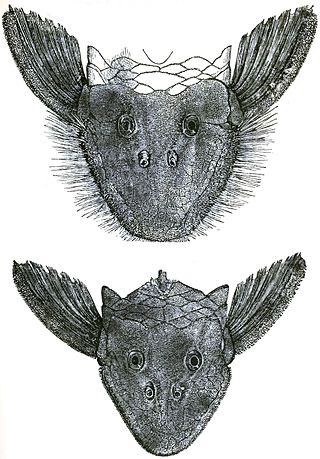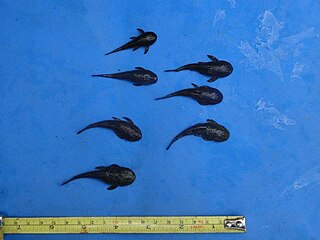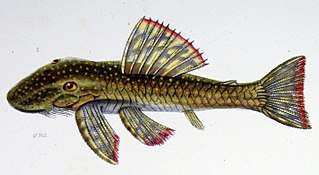
Ancistrus is a genus of nocturnal freshwater fish in the family Loricariidae of order Siluriformes, native to freshwater habitats in South America and Panama. Fish of this genus are common in the aquarium trade where they are known as bushynose or bristlenose catfish. In the aquarium hobby they are often referred to as bushynose or bristlenose plecos instead, but this may lead to confusion as "pleco" usually is used for Hypostomus plecostomus and its allies and is often used as a catchall term for any loricariids remotely resembling that species.

Loricariidae is the largest family of catfish, with over 90 genera and just over 680 species. Loricariids originate from freshwater habitats of Costa Rica, Panama, and tropical and subtropical South America. These fish are noted for the bony plates covering their bodies and their suckermouths. Several genera are sold as "plecos", notably the suckermouth catfish, Hypostomus plecostomus, and are popular as aquarium fish.

Hypostomus is a genus of catfish in the family Loricariidae. They are native to tropical and subtropical South America. H. plecostomus is the popular freshwater aquarium fish formerly known as Plecostomus plecostomus. The taxonomic structure of the Loricariidae is still being expanded by scientists. Hypostomus is a highly species-rich and widely distributed catfish genus.

Pseudorinelepis genibarbis is a species of armored catfish native to Brazil, Peru, and Ecuador where it is found in the Amazon basin.

Pterygoplichthys, sometimes collectively known as janitor fish, is a genus of South American armored catfishes. These fish are commonly known as sailfin armoured catfish or sailfin plecs, especially in the aquarium trade.

Baryancistrus is a genus of freshwater Loricariid catfish. They inhabit flowing sections of rivers, especially clearwater, in the basins of the Amazon and Orinoco in Brazil and Venezuela. The largest species reach up to 34 cm (13 in) in total length.

Pseudancistrus is a genus of suckermouth armored catfishes native to South America.

Hypancistrus is a genus of loricariid catfish originating from the Amazon basin in South America. Unlike many of the other Loricariids, however, some Hypancistrus species are more carnivorous and enjoy meat in their diet. Hypancistrus species are popular aquarium fish, including such popular fish as the zebra pleco and Queen Arabesque pleco.

Peckoltia is a genus of small South American armored suckermouth catfishes. Many of these fish are popular aquarium fish.

Hemiancistrus is a genus of suckermouth armored catfishes. These species are native to South America. The taxonomy of this genus is complex and unclear, and major work has to be done. Many of these fish are popular aquarium fish.
Pogonopoma is a genus of armored catfish native to rivers in south and southeast Brazil.

Rhinelepis is a genus of South American armored catfish.

Ancistrini is a tribe of catfishes of the family Loricariidae. Most are restricted to tropical and subtropical South America, but there are also several genus in southern Central America.

Lasiancistrus is a genus of suckermouth armored catfishes. They are native to South America and Panama.
Paralithoxus is a genus of suckermouth armored catfishes native to tropical South America.
Pseudolithoxus is a genus of suckermouth armored catfishes with five described species from the basins of the Orinoco, Casiquiare and upper Rio Negro in Venezuela. Additionally, a possibly undescribed species is known from the Trombetas and Nhamundá rivers in Brazil.
Lithoxus lithoides is a species of armored catfish native to Guyana and Suriname where it is found in stony rivulets of the Essequibo and upper Correntyne River basins. It can be found clinging to rocks in rapidly moving water. This species grows to a length of 8.6 centimetres (3.4 in) SL. It is the only species in its genus.
Peckoltia relictum is a species of armored catfish where it is found in the upper Marañon River in northern Peru.

Peckoltia sabaji is a species of catfish in the family Loricariidae. It is native to South America, where it occurs in the basins of the Rupununi, the Essequibo River, and the Takutu River in Guyana, as well as the basins of the Casiquiare canal, the Rio Negro, the Cinaruco River, and the Orinoco in Venezuela. It is usually found among boulders in medium to large rivers. The species reaches 19.8 cm SL and is of disputed classification.
Yaluwak is a genus of armored catfish native to South America where they are only known from Guyana, containing only a single species Yaluwak primus. It was first described in a 2020 study and placed within the tribe Ancistrini.














